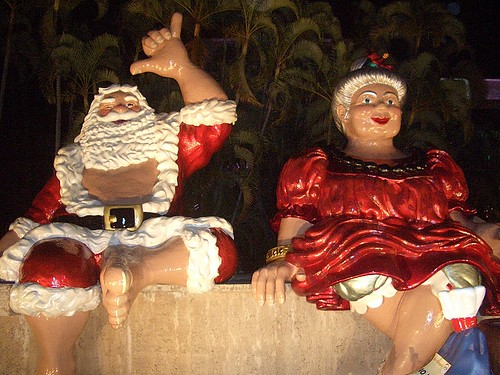WORD NERD ALERT!
Wherein we learn I’m crazy and also Merry Christmas.
“Mele Kalikimaka is Hawaii’s way to say Merry Christmas to you,” crooned Bing Crosby. It’s the “island greeting” for Christmas—but did you know it’s just “Merry Christmas”?
“Borrowing” isn’t just something your neighbor does with your lawn tools—it’s also an important linguistic process. In linguistic borrowing, the actual loan word (or phrase) is taken from the donor language, and often its sounds, spelling and/or pronunciation are adapted into the receiving language’s system of sounds.
The Hawaiian language has a short list of consonant sounds—eight, in fact: p, h, m, n, ? (the glottal stop; the sound between the vowels of “uh oh”), l (sometimes rendered n), w (sometimes rendered v) and k (sometimes rendered t).
What are these “sometimes t or k” letters? Most languages have more than one “allophone” of a letter: American English, for example, has 6 different pronunciations of the letter [phoneme, to be exact] /t/—as in cat, top, button, water, winter, and stop (more explanation below the bulleted list here). In Hawaiian, /t/ can be pronounced /k/ and vice versa. That particular variation is very rare.
You might notice in our list of sounds that there’s no s or r, both of which are kind of important in Merry Christmas. Hawaiian conveniently “maps” those sounds into the nearest relative, usually in terms of where the sounds are produced in the mouth. So R >> L. (I’ll spare you the productive phonetic reasons, unless you’re interested.)
So that gets us to Melly Chlistmas. Uh, yeah, this doesn’t sound much closer, does it?
Melly to Mele is pretty easy, right? There’s no ‘y’ and although the ee sound we make in Merry is closer to Hawaiian ‘i’ than ‘e,’ Hawaiian tends to prefer symmetrical vowels, so ‘mele’ is good enough.
Let’s tackle “Chlistmas.” The Ch makes a ‘k’ sound already, so Klistmas isn’t too hard to come up with, right? Well, in Hawaiian, native (i.e. not borrowed from other languages like this is, but oh well) words do not have clusters of consonants at the beginnings of syllables. (English has “phonotactic” rules, too—native English words don’t start with sd or ts, etc.)
So we need to break up the “Kl.” I don’t really know why we get an ‘a’ in there, and I could make some wild conjecture about vocalic position throughout the phrase, but that’s just crazy talk. We get an ‘a.’ Okay. One gimme.
All right, we’re at Mele Kalistmas. Now, we don’t have an ‘s’ in Hawaiian, and who says the ‘t’ in Christmas? Well, it’s possible that they did take the ‘t’—which you remember can also be a /k/ in Hawaiian—but I think it’s a little more likely that the /s/ sounds in Christmas got “mapped” into /t/. Notice how /s/ and /t/ are produced in essentially the same place in your mouth (the alveolar ridge) by the same part of the tongue—the only difference is the manner (plosive/stop vs. fricative). And if /t/ = /k/ in Hawaiian, apply a little transitive property, and add in some harmony with the beginning of the word . . .
Oh, sorry, I said no wild conjecture. I changed my mind.
We need a few extra vowels now, since we’re only at Kalikmak, or by syllables: ka-lik-mak. In Hawaiian, another rule is that a syllable can’t end with a consonant. So we add more vowel, repeating the one right before: ka-li-ki-ma-ka. (More syllables is BETTER!!!! Pfft, English, with its wimpy two syllable holidays.)
And now, I think we’ve done it. Merry Christmas —> Mele Kalikimaka!
So yes, I’m crazy. But any way you say it, I hope your Christmas is merry and bright! And I’ll see you back here next year!
Photo by Consuela Yokomura



Hi Jordan – you get an award!
http://thefarseas.blogspot.com.au/2012/12/goals-2012-summary-and-blog-of-year.html
Congrats